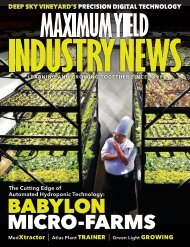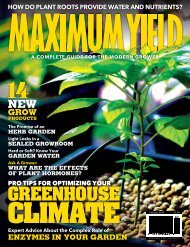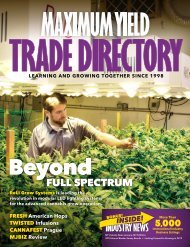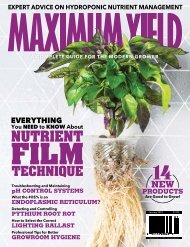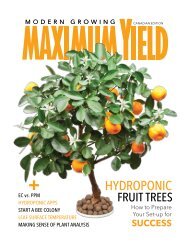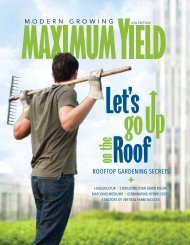Maximum Yield Modern Growing | Canadian Edition | May June 2017
In this issue of Maximum Yield, we cast a wide net to bring you the best and latest information possible to help you get started growing your own food. From the basics like cleaning your equipment to the best methods for preparing your plants to live outdoors, to more advanced topics like lighting and nutrient delivery, there is something in this issue for all levels of grower.
In this issue of Maximum Yield, we cast a wide net to bring you the best and latest information possible to help you get started growing your own food. From the basics like cleaning your equipment to the best methods for preparing your plants to live outdoors, to more advanced topics like lighting and nutrient delivery, there is something in this issue for all levels of grower.
You also want an ePaper? Increase the reach of your titles
YUMPU automatically turns print PDFs into web optimized ePapers that Google loves.
The key advantage of aquaponics is that it<br />
offers a crop of fish for the same amount of<br />
water that it would otherwise take just to grow<br />
the plants also by feeding the fish, you feed<br />
the plants.<br />
The difference with microponics is that you<br />
can access that benefit regardless of the plant<br />
growing system.<br />
Square foot gardening (SFG), pioneered<br />
by American Mel Bartholomew, is as waterwise<br />
as any aquaponics system and just as<br />
productive when it comes to growing plants.<br />
Sheet mulching (as described by the late Bill<br />
Mollison and David Holmgren of permaculture<br />
fame) is a soil-based option that is both waterwise<br />
and very productive. We’ve used square<br />
foot gardens and raised sheet mulch beds in<br />
conjunction with our aquaponics systems.<br />
We also use the nutrient-rich water to irrigate<br />
several fruit and fodder trees.<br />
Our use of water is leveraged even further<br />
given that the water from our aquaponics<br />
systems comes from rainwater tanks.<br />
Rainwater is better for plants because it<br />
is free of toxic substances like chlorine<br />
or chloramines. The use of water from an<br />
aquaponics system to irrigate plants is<br />
also better for the fish. Any accumulation of<br />
suspended solids or nitrates is kept in check<br />
by regular replacement with fresh rainwater.<br />
While microponics is distinguished by its<br />
encouragement of a wider variety of plant<br />
growing systems, its principal point of<br />
difference is its integration of microlivestock<br />
and other organisms. The prevailing<br />
wisdom in science says that the greater<br />
the biodiversity in an ecosystem, the better<br />
it is—and that’s where microponics really<br />
distinguishes itself.<br />
MICROPONICS ELEMENTS<br />
Useful microponics organisms include:<br />
• Fruit, vegetables, and herbs<br />
• Freshwater fish and crayfish<br />
• Japanese quail for meat and eggs<br />
• Chickens for meat and eggs<br />
• Fruit and nut trees<br />
• Muscovies and other waterfowl<br />
• Bees<br />
• Aquatic plants—duckweed, azolla, water<br />
spinach, and Chinese water chestnuts<br />
• Fodder plants and trees—pigeon pea,<br />
amaranth, comfrey, chou moellier, tagasaste,<br />
and moringa<br />
grow cycle<br />
53




